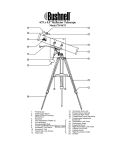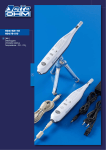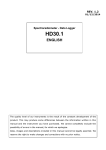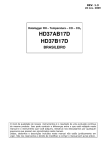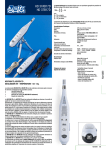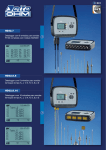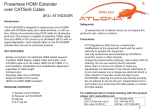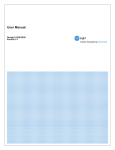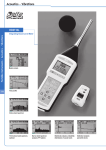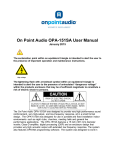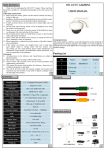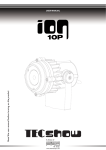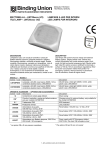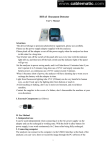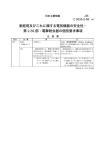Download HD 30.1 - Delta Ohm S.r.l.
Transcript
HD 30.1 [ GB ] Spectroradiometerdatalogger [ GB ] Description [ GB ] The HD30.1 is an instrument made by Delta Ohm for the spectral analysis of light in the visible range and ultraviolet. The instrument has been designed by combining the maximum flexibility of use, cost reduction and ease of use. It consists of two elements connected together by a cable: the data logger-indicator HD30.1 (fig. 1) and the measurement sensors (fig. 2) HD30.S1 (spectral range between 380nm-780nm) and HD30.S2 (spectral range between 220nm-400nm). The datalogger-indicator HD30.1, based on the Linux operating system, makes processing and data management (fig. 3). It has a large touch screen color display, which allows for an easy implementation of the measures, as well as their display and storage (fig. 4). The spectra and the derived parameters can be saved both in the internal memory (150MB) and in the external memory (micro-SD card or USB key). The export format is compatible with the most common programs for the analysis and processing of data. In addition to the data backup, the software allows to save images of the graphs. Fig. 3 The sensor HD30.S2 analyzes the ultraviolet spectral band (220 nm-400 nm) and calculates the following radiometric quantities: UVA irradiance (W / m2), UVB irradiance (W / m2) and UVC irradiation (W / m2) The main quantities of photo-radiometric interest are calculated from the HD30.1 by the supplied software. The analyzed spectral range varies depending on the sensor used to measure: Visible spectral region (380nm-780nm) by means of the sensor HD30.S1, Ultraviolet spectral region (220nm-400nm) by means of the sensor HD30.S2. The measuring sensors are interchangeable and calibrated (the calibration file is stored within each probe). The sensor HD30.S1 analyzes the visible spectral range (380nm-780nm) and calculates the following photo-colorimetric quantities: Illuminance [lux], Correlated Color Temperature CCT [K], Trichromatic Coordinates [x,y] (CIE 1931) or [u’,v’](CIE1978), CRI (color rendering index, R1…R14, Ra) , PAR [μmolfot/sm2]. Fig. 4 Both sensors have an optical input equipped with a new generation diffuser that optimizes the response according to the cosine law and does not introduce any spectral deformation. The data relating to the calibration of each probe are stored in the permanent memory and are read by the indicator. The system works with internal batteries (rechargeable, 3.7V, 6.6Ah) or connected to the external power supply (SWD06), which has the dual function of powering the unit and charging the battery. The battery life while the instrument is working is approximately 10 hours, which may increase in particular conditions of use. Fig.1 datalogger-indicator HD30.1 USB Imput probe HD30.S1- HD30.S2 ON/OFF MicroSD Card MiniUSB Ethernet Battery charger power supply Appilications Data logger-indicator HD30.1 with the probe HD30.S1 (visible): In recent years in the lighting field, we are witnessing the advent of LED lighting. The advantages from the point of view of energy compared to conventional systems is not in doubt, even if the performance in terms of color rendering (CRI) are not uniform between different production batches and may vary from manufacturer to manufacturer. With traditional light meters you can just check the level of illuminance [lux] but not the quality of the illumination produced. Therefore it is necessary to accurately control the colorimetric characteristics of the sources installed in order to evaluate not only the quantity but also the quality. In the industrial environment, a high color rendering reduces the fatigue of visual field and, in cosmetics, a high color rendering is needed to enhance the quality of the exhibits. Even more important is the control of the spectrum of the sources installed in the museum environment where the quality of lighting has the dual task of ensuring the optimum viewing of the exhibits (high CRI) and a low emission of blue-violet light that may degrade the materials of the exhibits. Some neonatal therapies are based on lamps that emit blue light, the appropriate level of radiation can be measured by using the HD30.1. In this case, the light emitted out of the useful spectral band not only decreases the effectiveness of the therapy but can be harmful. Data logger-indicator HD30.1 with the probe HD30.S2 (ultraviolet): The ultraviolet light is used in the most various industrial and civil sectors. Quite often it is not enough to know the total emission of the source, but it is crucial to know how this light is distributed in the spectrum. This is because many processes (sterilization, polymerization and others) are very sensitive to the wavelength of the incident light and not only to its intensity. In the medical field, some diseases of the skin are treated with the use of UV lamps (UVB), also in this case not only the intensity of light that reaches the skin is important but also its wavelength. Fig.2 Sensor HD30.S1, Sensor HD30.S2 Specifications MODELLO Sensor Spectral Field Type of spectrometer Numerical Aperture Inlet Slit Band-pass Wavelength accuracy Reproducibility of the wavelength Averaging Time Averaging Mode Diffused Light Measuring Mode Type of Measure Optical input dimensions (opaline quartz diffuser) Cosine correction Calibration Working field Uncertainty HD30.1 + HD30.S1 HD30.1 + HD30.S2 CCD linear (2048 elements) CCD linear (2048 elements) 380 nm – 780 nm 220 nm – 400 nm Based on diffraction grating in transmission 0.16 125μm 70μm 4.5nm 2.5 nm 0.3 nm 0.1 nm From 1ms to 4 s Automatic/manual <0.03% <0.03% Spectral Irradiance, Irradiance, Illuminance [lux], PAR , Correlated Spectral Irradiance, UVA Irradiance, UVB Irradiance, UVC Irradiance, Colour Temperature, Trichromatic coordinates CIE 1931 (x,y) & CIE Spectral Transmittance 1976 (u’,v’),CRI, Spectral Transmittance Single, single acquisition with data backup - Continue, continuous acquisition with data backup Monitor, acquisition continues without saving data - Logging, acquisition at time intervals (from 3min to 60min) with data backup \ 11.8 mm By means of opaline quartz diffuser (3mm) Halogen Standard Lamp Illuminance 5-70000 lux Spectral Irradiance ± 5% Illuminance ± 4% PAR ± 4% CCT ± 45K x,y ± 0.002 CRI ± 1.5 Operating System Display Data Storage PC connection Power Supply Exported data format Dimensions/weight of the indicator HD30.1 Dimensions/weight of the probe Working temperature Upgrade By means of opaline quartz diffuser (2mm) Deuterium Standard Lamp Spectral Irradiance UVA Irradiance UVB Irradiance UVC Irradiance Linux 4.3” touch screen (480x272 pixel) Internal (150 MB), micro SD card, USB key (not supplied) via Ethernet cable, via mini USB connector. Rechargeable 6600 mA/h battery Li-po, 3.7V or external power supply SWD06 (6Vdc) Compatible with the best known management software /data analysis 135x 156 x H 42 mm 440 g 75x150x H74, cable length 1.5m 370 g 0°C-40°C automatic via internet PURCHASING CODES HD30.1 + probe HD30.S1: Datalogger-indicator HD30.1 equipped with the HD30. S1 probe for measuring the visible spectral band (380nm-780nm), 4GB micro SD card, power supply/battery charger SWD06, plastic case and CD with User’s Manual and Calibration Report. HD30.S2: HD30.S1 probe for measuring the ultraviolet spectral range (220nm400nm). ACCESSORIES SWD06: power supply/battery charger for HD30.1 BAT30: 6600mA, 3.3V replacement battery for HD30.1, Micro SD: 4GB Micro SD card HD30S: Additional copy of the software VTRAP: Tripod to be fixed to instrument, max height 280mm CALIBRATION REPORTS VCERT-L27: Calibration of spectral irradiance between 380 nm and 800 nm, carried out by measuring the irradiance produced by a reference halogen lamp. VCERT-L28: Calibration of spectral irradiance between 200 nm and 400 nm, carried out by measuring the irradiance produced by a reference deuterium lamp. VCERT-L29: Calibration of spectral radiance between 300 nm and 800 nm, carried out by measuring the radiance generated by a reference integrating sphere. ± 15% ± 6% ± 8% ± 10%




